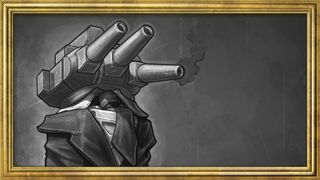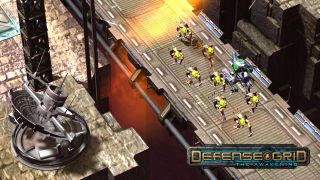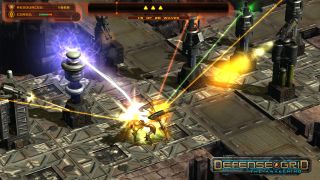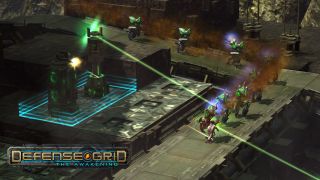Defense Grid, the 'beer game' that changed a genre
With its minimalist plot and freeform difficulty, Defense Grid: The Awakening became a tower defense classic.

"We wanted to make a beer game," says Michael Austin, creative director and co-founder of Hidden Path Entertainment. "That's a game you can play with one hand while holding a beer."
Though Austin and his fellow veterans at Hidden Path had previously worked on several games, Defense Grid: The Awakening was their first self-published title. They released it in 2008, when the tower defense genre was still mostly mods for games like Warcraft 3 and a few smartphone and browser games. Austin saw a fellow employee playing Desktop Tower Defense, and became inspired. "I wanted to make a AAA tower defense game, since the genre had only been in mods and flash games so far. I wanted to make Defense Grid because that's a game I wanted to play."
Defense Grid: The Awakening was originally set to release on Xbox Live Arcade, through a publishing deal with Microsoft. "Two months before we were going to launch on Xbox Live Arcade, they delayed us a by a year, because they had a similar game launching at the time," says Austin. (That other game was South Park Let's Go Tower Defense Play.) "But we needed the funding, so we went to Steam. It was a new platform, maybe it'll be big some day?"

Defense Grid: The Awakening was one of the early third-party games released on Steam—Austin boasts that it has a five-digit Steam ID—and proved hugely successful. The campaign featured 20 levels with multiple medals to earn and challenge modes to unlock, making for a large variety of replay with minimal design work.
When you're playing this game you feel like you are the last bastion defending earth against the invaders. Having someone cheering you on and appreciating what you're doing was really important.
Michael Austin
"The design challenge is making a game that everyone can pass, but that still has a ton of depth," says Austin. Defense Grid achieved that with its cores—each map featured a number of glowing orbs that needed to be protected from the onslaught of invading aliens. If enemies reached a core they would pick it up and begin the long trek back, giving players a second chance at redemption. It gave them a unique sliding scale of victory.
"That presented a huge amount of difficulty range," Austin continues. "The expert players wouldn't let the aliens touch a single core, while beginners could be proud that they survived with a single core left. It gave a wide range of challenge within a single map, without having to select a difficulty."

Another of Defense Grid's memorable qualities is the minimalist story, told through the solitary AI character, Fletcher. "We originally wanted cutscenes but didn't have the budget," says Austin. "We wanted to do interactive dialogue between the player and the computer AI. It was frustrating because people didn't care about the story. I went to our writer and told her we needed to get rid of one of our characters. We only had two characters!"
The biggest gaming news, reviews and hardware deals
Keep up to date with the most important stories and the best deals, as picked by the PC Gamer team.
The story was further hacked up and refined, until a succinct, poignant tale of a lonely AI defending the world was left. "I look it at as this great loss of a fantastic story and cutscenes," says Austin. "But now when you play the game people praise the story and the talking AI. When you're playing this game you feel like you are the last bastion defending earth against the invaders. Having someone cheering you on and appreciating what you're doing was really important."
Though GLaDOS is a lot less friendly, comparisons between the story and that of Portal are not lost on Austin. "I think Portal was definitely an influence," he says. Valve didn't seem to mind—they were so impressed by Defense Grid they licensed GLaDOS for a special DLC level pack. The partnership didn't end there. "We got a lot of opportunities from Defense Grid, a lot of reputation," says Austin. "We did a little game called Counter-Strike: Global Offensive purely because Valve loved Defense Grid and wanted to work with us."
In the decade since, Hidden Path has returned to tower defense several times, including a series of DLC level packs and a Kickstarted sequel. Or was it an expansion? "We wanted to make Defense Grid 2 for a while, but we didn't have the budget for it. We went to Kickstarter and learned a valuable lesson," says Austin. "We wanted to Kickstart a Defense Grid expansion, and if it funded enough we could do Defense Grid 2. Turns out that's a really complicated message to explain."
The campaign technically funded, but only enough for an expansion to the original game, leaving lots of backers and fans confused and disappointed. The expansion, Containment, released in 2013, five years after the base game's initial launch.
Defense Grid 2 was eventually funded thanks to an angel investor. Hidden Path added two major features they weren’t able to fit into the original: multiplayer and a level editor. But during development they may have forgotten the reason people loved the original story. "We went big on the story, which we probably shouldn’t have," Austin explains. Defense Grid 2 sold well, but not well enough to produce a third game, and the map editor had replaced the need for DLC.

In the following years Hidden Path has successfully pivoted to producing VR games, applying many of their design choices and philosophies to their new best-sellers. "We've pulled the degrees of success—that you can succeed, and there's a harder success bar to cross—into a lot of our games," says Austin. Their latest VR game, Brass Tactics, is an RTS that creates the feeling of miniatures in a tabletop wargame. Even with their experience on the Defense Grid games it took them six months to nail the interface, and trying to drink a beer while playing VR is probably not recommended.
A decade later Defense Grid: The Awakening remains one of the most beloved tower defense games ever made. Many tower defense games hybridize the genre with varying degrees of success (Austin is particularly fond of Sanctum and the many ways it plays homage), but Defense Grid maintains its position as one of the best vanilla tower defense games there is, and is uniquely enjoyable by both newcomers and hardcore veterans alike.
"As somebody in entertainment the best feeling ever is having someone tell you about their story with your game and their experience," says Austin. "Defense Grid has brought me many stories, like their eyes lighting up when they tell me about a juggernaut about to make off with the last core, only to get gunned down at the final second, giving them the victory. That's why I'm in games."
This article is part of the Class of 2008, a series of retrospectives about indie games that were released 10 years ago.
Most Popular


